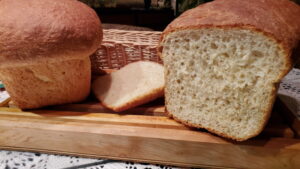Special baking aroma!

This recipe makes two large loaves of delicious buttermilk corn bread. Perfect with a bowl of soup, Italian or French dishes, and makes terrific toast and sandwiches.
Especially when freshly-baked, you will be tempted to spread butter over this delicious loaf of corn bread, and eat it as is. It goes well with soup and with such spreads as jam and peanut butter. The salt in the recipe is optional, or you can use a salt substitute. Expect a fresh, and just-slightly-sweet taste. This bread recipe is a sure-fire family favourite.
Ingredients
- Start three to four hours before serving;
- This recipe will make two loaves of corn bread. Two glass baking dishes are needed, though you can put the entire loaf in the oven to bake free-form.
| Ingredient | Quantity |
|---|---|
| Cornmeal | 125 mL |
| Boiling water | 250 mL |
| Warm milk | 250 mL |
| Egg (room temperature) | One (1) |
| Granulated sugar (for regular yeast) |
15 mL (one tablespoon) |
| Yeast (instant or regular) | 2 pkg (about 2 scant teaspoons) |
| Salt or salt substitute (for regular yeast) |
1.25 mL (¼ teaspoon) |
| Dark brown sugar | 65 mL |
| Gluten flour (optional) | 30 mL (2 tablespoons) |
| • All-purpose unbleached flour • Whole wheat flour • Bread flour |
2½ cups 1 cup 1 cup |
Preparation
- Add the corn meal to the boiling water, and stir vigorously until it forms a thick mixture. This should take 4 to 5 minutes;
- Place the corn meal in a mixing bowl, and let it cool;
- Traditional yeast: Proof the yeast with the granulated sugar in the water. Once proofed (about 5 to 10 minutes), pour into the mixing bowl with the cooled corn meal, and mix well;
- Mix the dry ingredients: If you are using instant yeast, add it to the dry ingredients: flour, sugar, salt. Stir to mix the dry ingredients well;
- Mix the liquid ingredients: Add the warm milk and egg to the warm corn meal, and mix well. If you used traditional yeast, add it to the liquid ingredients. You can use a hand egg beater to mix the liquid ingredients;
- Slowly add the liquid ingredients to the dry ingredients, mixing continuously. An electric mixer is useful to stir continuously until the bread dough pulls away from the side of the bowl;
- Kneading: Once the bread dough pulls away from the side of the bowl on its own, transfer to a lightly-floured board, and begin kneading the dough;
- Work the dough until it is smooth and spongy. This may take 10 to 12 minutes. Add more flour to the board as needed;
- First Rising: Butter a large mixing bowl, and place the dough inside to rise in a warm, moist place. We put a layer of very warm water in the sink, and cover the sink with the kneading board. Allow the bread dough to rise for at least two hours or until at least doubled in mass;
- Turn the bread dough back onto the floured kneading board, punch down, and knead again for a few minutes. Cut into two equal halves. Butter the two baking pans, and place each half in a buttered baking pan;
- Second Rising: Repeat Step 8 with the two buttered bread pans, and allow the bread to rise again. It should about double in bulk;
- Baking: Near the end of the rising time, set the oven to 425°F (235°C). Place the two bread pans in the oven for ten minutes, then reduce the temperature to 350°F (175°C), and continue baking for another 25 minutes. The bread should be nicely browned, and sound hollow if you tap the top. Remove from oven, and take the bread from the pans. Place the loaves on the oven rack (the oven can be off, but cooling) to let the crust get crisp. Allow to cool before slicing.
Variation
Try a half-and-half mixture of two percent milk and buttermilk for a unique taste to the bread.


